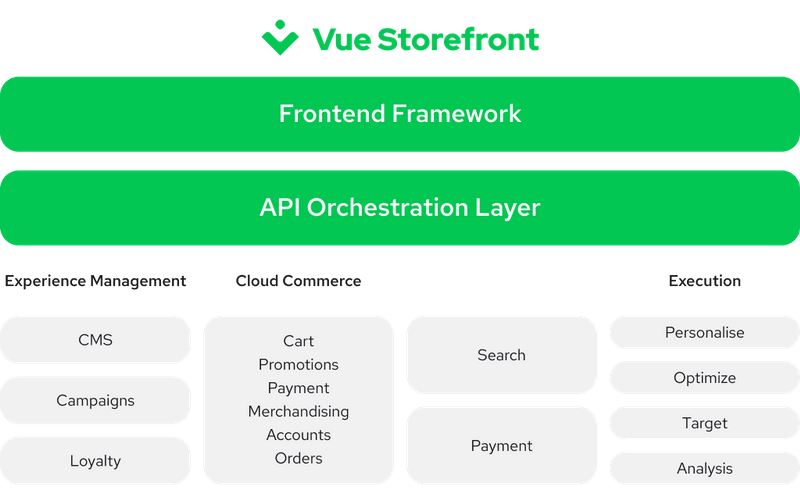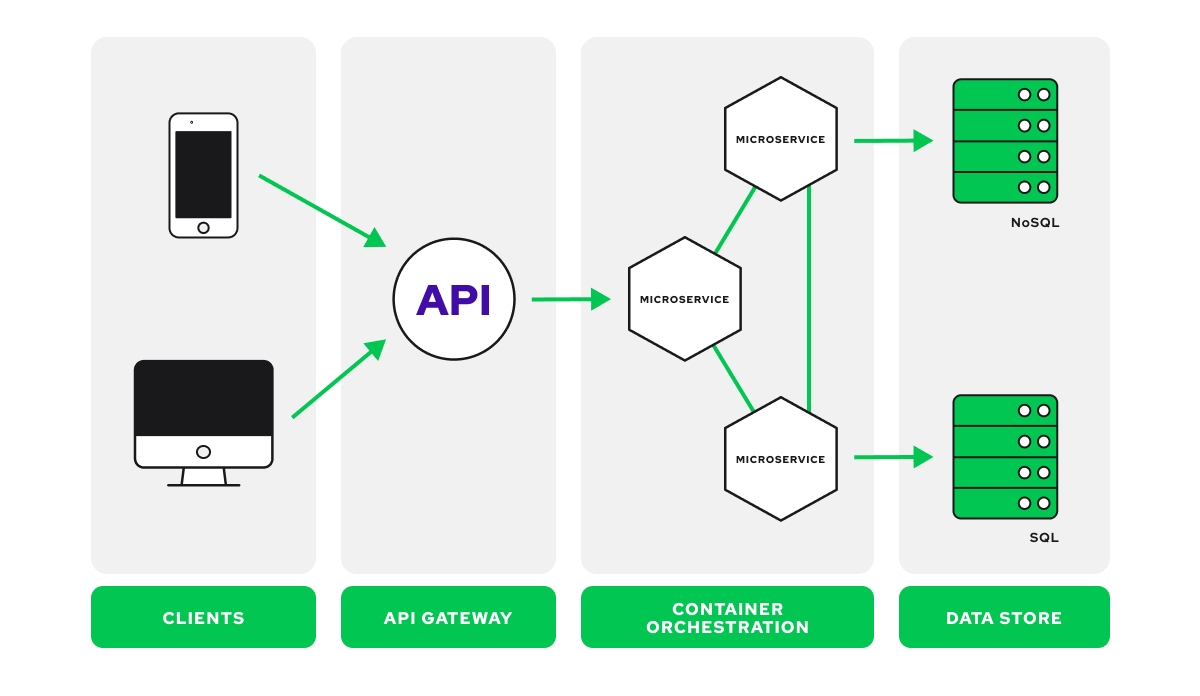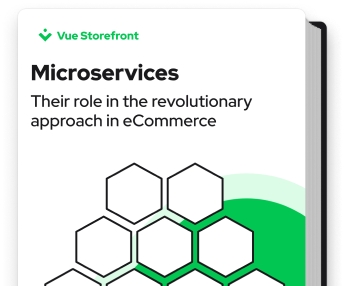Explore by Category:
Microservices
Microservices in eCommerce Explained
Monoliths, all-in-one platforms, revolutionized the shopping landscape over twenty years ago. Now, the time has come for another upheaval. One-fits-all eCommerce solutions on which launching a website was the way to start online retail are becoming obsolete.
Omnichannel and mobile-first require agile software that keeps up with market demands and helps improve revenue. Growing competition, new strategies, and advancing customer expectations mean that brands need to be fast, flexible, and responsive. Loosely coupled microservices are an answer to the challenges today's eCommerce faces.
Keep reading to discover:
- What are microservices?
- What are the principles of microservices?
- What is the meaning of loosely couple software in eCommerce?
Microservices Architecture in eCommerce
Microservices architecture is a concept of building an application based on breaking it into multiple modules. Each module has its own specific responsibilities but communicates with others to form a unified system. This approach provides freedom of development and choice of tools (technology language, framework) within each application.

Microservices are broadly adopted during digital transformation in many areas, however, in eCommerce, these find special recognition. That’s because of the flexibility the modular architecture provides and the convenience of further composition and development of the entire software system.
Microservices allow eCommerce businesses to adapt quickly and keep up with market demands.
What are Microservices?
Simply put, a microservice is a small application dedicated to serving a specific task. In other words, a microservice is a small component that can be easily replaced, independently developed, and installed, as a part of a larger software system composition.
Microservices work jointly to execute the work of a standalone application in a more efficient way. The term ‘microservices’ refers to each application operating as a small independent service.
One of the true meanings of a microservice-based architecture for eCommerce is that it makes it simple to compose easy-to-scale software. Since it is a decentralized system, the microservices framework is also a highly deployable one, enabling organizations to escape the bottlenecks of a monolithic architecture (a system in which all components are consolidated into one core closely linked system).
Monoliths Drawbacks
A monolithic application is all-in-one and follows the early principles of software design. Monolith contains all the features and functions in one application and one codebase. That entails certain limitations:
- Monolith applications are too complex to entirely understand and implement changes quickly and correctly.
- Each update requires the deployment of the entire application.
- The impact of a modification is usually difficult to forecast, which leads to extensive manual testing.
- Monolithic applications are difficult to scale when various modules have incompatible resource requirements, continuous deployment is hard.
- Poor reliability. Any bug in any module (e.g. memory leak) can potentially bring down the entire function.
- The centralized nature of a monolith system does not allow many dev teams to work independently. Moreover, since all instances are identical, that bug will impact the entire application. In case the system is extensive, finding the hot spot requires scanning hundreds of lines of code and can take weeks.
- Monolith limits the adoption of new technologies. Because changes to frameworks or languages affect the entire application, it is extremely resource-consuming both in terms of time and cost.
- Monoliths force the use of only one technology, which is a blocker to integration with other systems or APIs.
These drawbacks block scaling and further development; however, monolithic software will serve well in cases where business does not have frequent needs to quickly implement changes. Monolith can be a good option if the business expects the system to be relatively small and support few processes.
For fast and frequent deployments, microservices are an excellent choice to solve the problems encountered by monoliths. Agile, fast, and smart - more on that later in this piece.
Microservices vs Service-Oriented Architecture
SOA (Service-Oriented Architecture) focuses on building large systems out of integrated, logically divided services. In general assumption, this approach is to eliminate the main problems caused by coupled monolithic architecture.
Service-Oriented Architectures are built on or migrated over time by employing the Enterprise Service Bus (ESP). The solution (ESP) is responsible for communication routing, document mapping, handling various endpoints, auditing and security.
This all sounds good in theory, but the multipurpose nature of the solution turned the bus into yet another monolith over time. Centralization, performance bottlenecks, and a single point of failure contributed to the solution being treated as a dead end and an insufficient tradeoff for scaling with monolithic maintenance.

Microservice architecture is in fact the execution of the SOA assumptions. Only the way of communication differs.
The essence of the solution is a point-to-point exchange of information. The goal is to eliminate the bottleneck and enable the independent development of projects. Instead of a monolithic application, one gets independent applications developed by separate teams.
Microservices incorporate components that are specific to SOA. The application is divided into services with individual components communicating with each other.
However, the microservices architecture is loosely coupled. Thanks to that, their operation is possible even if one of the components of the service is unattainable. So for users and businesses, this does not cause unavailability of the whole system.
Microservices Principles
Here are some key design principles for microservices-based applications:
1. A microservice has a single responsibility
This relates to the term ‘micro’. As part of the SOLID design practice (in software engineering, SOLID is an acronym for five design principles intended to make software designs more understandable, flexible, and maintainable) single responsibility implies that a microservice should have only one answer.
This means that the microservice interface should expose only access points that are relevant to the assigned function. And internally, the microservice should have only assigned behavior.
Providing a single responsibility means that microservices are easier to maintain and scale.
2. A microservice is built around business capabilities
Domain-driven design (DDD) is an architectural direction. DDD recommends designing systems to reflect the real-world domains. It accounts for the business domain, elements and behaviors, and interactions between business domains. For example, online retail microservice offers services related to that eCommerce-specific functions.
Microservices should focus on individual business functions. Each microservice shall never restrict itself from adopting an appropriate technology stack or backend database storage that is most reasonable for solving business issues.
This is one of the limitations provided by monolithic applications, which attempt to solve multiple business solutions with some compromises. Microservices allow for selecting what is best for a given problem.
3. A microservice is decentralized
Each microservice can be developed in separate technologies and platforms. Hence, decentralized governance. An approach to building microservices is to produce useful tools that can then be utilized among communities to solve the same problems.
Along with decentralized governance comes decentralized data management. A microservice application contains and manages its unique database. For comparison, monoliths use a single logical database across different applications.
4. A microservice is failure resistant
A microservice should be designed with failure scenarios in mind to calculate how service failures could affect the user experience. Because services can fail at any time, it’s important to secure these collapses quickly and, if possible, automatically restore service.
Real-time monitoring of the application, checking architectural elements (requests per second to the database) and business relevant metrics (orders per minute received) are some of the best practices implemented among microservices to monitor proper functioning.
5. A microservice is future-proofed
Yet another forward-thinking approach toward microservices architecture is an evolutionary design. Micro-software practitioners have years of learning and refining behind them. Hence, speedy for evolutionary systems where one can secure architecture for example for the types of devices that may one day access an application.
Breaking software into components means the monolith still can be a core. However, adding new features is more scalable via building microservices that use the monolith's API. Decomposing monoliths is a more agile approach to shaping modern user-focused instances.
Many businesses began on monolithic architecture, but with growing demands and facing digital transformation they slowly migrate to microservices that interact over monolithic architecture through APIs.
Microservices Diagram
The Microservices architecture diagram is the visual representation of the concept of an application that incorporates multiple microservices and how those services are communicating with each other through the APIs.
From the diagram given below, we can see an app that communicates with the user through a mobile application and a web application. The key point is that this application is created by multiple microservices. This diagrammatic presentation captures the general idea of how microservices function.

Each microservice can be accessed in one of two ways in this schematic application:
- From an API gateway (via a mobile app)
- From a Web application (via the user’s web browser)
Note: More could be made, as the architecture is designed to achieve this.
Each microservice exposes a REST API (also known as RESTful API) is an application programming interface (API or web API) that conforms to the constraints of REST architectural style. This interface defines the operations that can be achieved with the respective microservices. Also, details the data structures, or data types that can be handed into the microservice as well as its return types.
A single microservice has its own set of responsibilities. Each one can only interact with its own database. With a microservice, businesses get the benefits of flexibility provided by loosely coupled systems. Each microservices architecture can work freely.
Microservices Design
The architectural composition of microservices consists of:
- A microservice – a small independent service
- Containers – package services and their dependencies.They make sure that the unit is consistent throughout the entire development process, this includes testing
- Service mesh – facilitates communication between microservices via a dedicated dynamic messaging layer
- Service discovery – helps microservices to locate each other in an ecosystem
- API gateway – an open path between microservices and outside clients. Together intercommunication and data exchanges form the functions of a complete application
Each service has a separate IP address and exposes an interface that is language-agnostic. The most popular is a REST API (also known as RESTful API), but other models for communication exist (e.g. GraphQL API). Microservices also generally get deployed as containers (a lightweight isolated operating environment for workloads) when it's time to go live.

Each service design and architecture is:
- Unique. Service design and implementation aim for performing a specific function or meeting a specific requirement.
- Decentralized. Services have few, if any, dependencies optimally, although loose coupling necessitates frequent and extensive communication. Still, decentralized microservices are connected together to form a high-performing system.
- Resilient. Services, in general, need to be designed for maximum fault tolerance. A single microservice malfunction should not disrupt the entire application.
- API-oriented. An architecture of microservices relies on APIs and API gateways are a great approach to facilitate communication among infrastructure.
- Data-separated. Each service has its own database or storage volume ready to be accessed.
Why Are Microservices So Broadly Used in eCommerce?
Online retail needs to keep up with constantly evolving customer expectations. eCommerce Microservices Architecture is the perfect solution for:
- Scaling
- Fault isolation
- Providing technology stack independence
- Ensuring data security
What else?
Microservices and an API-first approach fit into modern commerce requirements. With loosely coupled architecture it’s easy to integrate with any third-party system. Upgrades happen faster with fewer resources. eCommerce Microservices Architecture facilitates quick data exchange.
Microservices software enables new opportunities for businesses focusing on customer experience. An additional benefit is working on microservices frameworks with a modern stack and the support of a large group of tech enthusiasts.
FAQ
What are microservices?
Microservices architecture, or simply microservices, is a unique method of developing software systems that focuses on building single-function units with well-defined interfaces and operations. In recent years, this trend has grown in popularity as businesses seek greater agility and move toward DevOps and continuous proofing.
What are the benefits of microservices?
Microservices offer many benefits over the traditional complex monolithic architecture. Among them is flexibility when choosing the most suitable technology, built with a specific purpose, simple and smaller in size, easy to multiply and scale the business, and can be developed by smaller and independent teams.
Why do microservices matter in eCommerce?
Microservices, thanks to their agility and loose coupling, allow for rapid deployment and scaling of the business to meet specific requirements. Microservices are the answer to the limitations created by monoliths.
What is microservice architecture?
Microservice architecture is a software approach toward forming flexible, agile, and easy to scale extensive business logic. It enables the fast, frequent and reliable delivery of large, complex applications. Microservice architecture also enables an organization to update its technology stack. In addition, it opens the door to headless transformations and follows one of the paradigms of combining a best-of-breed enterprise technology ecosystem, supported by MACH Alliance.
Share:
Share:
Ready to dive in? Schedule a demo
Get a live, personalised demo with one of our awesome product specialists.




















